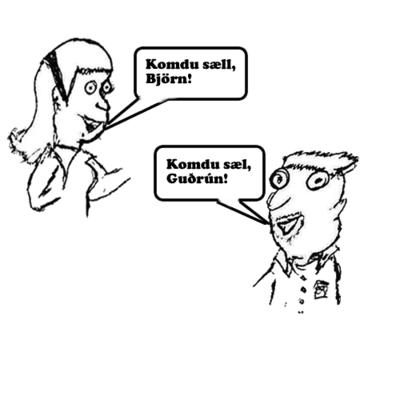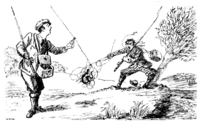Icelandic/Lesson 1
< Icelandic| Icelandic |
Forsíða | Inngangur | Stafróf og framburður | 01 | 02 | 03 | 04 |
| Viðaukar: Stórir Bókstafir | Nafnorð | Sagnorð | Óregluleg sagnorð | Lýsingarorð | Atviksorð | Töluorð | Klukkan | Annað: Verkfæri |
Kafli 1: Halló!
- Lesson 1: Hello!
|
In this lesson you will learn: |
Fyrstu orðin (The first words)
|
|
|
|
|
|
Kveðjur og orðasambönd (Greetings and phrases)

|
Athuga
- When talking to or about someone, gender is an important part of Icelandic conversation and speech. For example, when greeting a man, you must say Komdu sæll, blessaður or sæll. To a woman, you would say Komdu sæl, blessuð, or sæl
- If the situation is informal, you can just say Hæ or Bæ regardless of gender
- When there is a group of people of mixed gender, you could say Komið þið sæl og blessuð
- When you want to welcome someone, you also must take into account the gender of the listener. If you are welcoming a man, you say Velkominn, if a woman, you say Velkomin. If you are welcoming a group of people, you also would say Velkomin
- Although Allt í lagi means okay (Ok!), you will of course also hear ókei, said the same as the English okay
- As you may have noticed, Góða daginn (or Góðan dag) means both good morning and good afternoon. Icelanders use this greeting from the early morning hours (after midnight) until slightly before dinner time. In Iceland, since there is sunlight almost 24 hours in the summer months and about 4 hours in the winter months, using these greetings based on how it looks outside is not a good reference
- Remember that the letter Æ is pronounced like the English i in mine. Refer back to the Alphabet and Pronunciation page if you are struggling with reading words in Icelandic. The phonetic pronunciation will go away after this lesson, since Icelandic words are pronounced as they are read. Therefore, it is essential that by the end of this lesson, you are comfortable with the Icelandic alphabet and how it is pronounced
Málfræði (Grammar)
Nafnorð (Nouns)
A noun is a person, place, or thing. It has the same function in Icelandic. Nouns in Icelandic, unlike English, are reflected by their case, gender, and number. There are 4 grammatical cases in Icelandic (Nominative, Accusative, Dative, and Genitive) which we will talk about individually.
Kyn (Gender)
This might seem odd for an English speaker, a word in a language having gender? There are many languages that do indeed give their nouns gender. In Icelandic, we have three genders, masculine, feminine, and neutral nouns. When learning new vocabulary, it is important that you establish its gender whilst you memorise it. This will come in great importance when declining the noun and using it. There are some simple rules to determine if a noun is masculine, feminine, or neutral:
|
The word is masculine if:
maður stóll fáni banki strákur bíll |
The word is feminine if:
kona flugvél stöð spurning stelpa verslun |
The word is neutral if:
barn land ball herbergi tré bakarí |
Greinir (Articles)
An article is a word that combines with a noun to indicate the type of reference being made by the noun. In English, articles are the, a, and an. In Icelandic, there is no indefinite article, meaning there is no way to say a or an in Icelandic. Therefore, the word maður could mean man or a man. You determine the proper translation by the context, which isn't as difficult as it might seem at first.
There is however a definite article (the). Unlike English though, Icelandic has postfixed definite articles, meaning the article attaches itself to the end of a word to make it definite. For example, in English, you would say the man, whilst in Icelandic we say manthe. This might be confusing at first, but in time you will get used to this. Let's take a look how we form the definite article in Icelandic.
- Karlkyn (Masculine) -inn, -nn
- Kvenkyn (Feminine) -in, -n
- Hvorukyn (Neuter) -ið, -ð
Maður → Maðurinn - Man → The man
Kona → Konan - Woman → The woman
Barn → Barnið - Child → The child
Barnið er strákur - The child is a boy
Allt í lagi? Skilurðu? (Do you understand?). Pretty soon we will be able to construct simple sentences.
Nefnifall (Nominative Case)
The Nominative case, or Nefnifall, is the first case we will talk about. This case also exists in English, though we do not think about it when we use it. This case represents a noun that acts as the subject of the sentence. It is also used in equivelent sentences, such as sentences which use the copula verb to be. (For example: I am a man). The nominative form of the noun is also the dictionary form. The words you have just learnt in this chapter are all in the nominative (strákur, stelpa, maður, kona). Examine this chart and examples below:
Fornöfn (Pronouns)
Pronouns are nouns which substitute other nouns in a certain phrase or sentence. For example, in English pronouns are I, you, he, she, it. In Icelandic they are:
| English | Icelandic | English | Icelandic | |
|---|---|---|---|---|
| I | Ég | We | Við | |
| You | Þú | You (plural) | Þið | |
| He | Hann | They (masculine) | Þeir | |
| She | Hún | They (feminine) | Þær | |
| It | Það | They (neuter) | Þau | |
- Note that when you have a group of males, you use Þeir and if you have a group of females then you would use Þær. If the group is of mixed gender, then use Þau.
Tengisögnin "að vera" (The copula "to be")
The most important verb in any language is the verb "to be". It is important to know how to say things like I am, you are, he is, she is and so on. The following table is a verb conjugation. Conjugating verbs is an important part of learning a language. We can't just say I to be, you to be, he to be. We have to conjugate a verb in order to find the appropriate form for the adjective. First we will show you how it is done in English, than the Icelandic equivelent. Remember your pronouns?
![]() TO BE
TO BE ![]()
| Pronoun | Conjugation | Pronoun | Conjugation | |
|---|---|---|---|---|
| I | am | We | are | |
| You | are | You all | are | |
| He, She, It | is | They | are | |
![]() AÐ VERA
AÐ VERA ![]()
| Fornafn | Sagnbeyging | Fornafn | Sagnbeyging | |
|---|---|---|---|---|
| Ég | er | Við | erum | |
| Þú | ert | Þið | eruð | |
| Hann, Hún, Það | er | Þeir, Þær, Þau | eru | |
To make a question, you do the same as you would do in English, flip the verb and subject around. (Er ég? = Am I?, Er hann? = Is he?). You will also commonly see Ert þú combined into Ertu. Don't be put off by this, ertu simply means are you, although ert þú is also correct and a bit more formal.
Now that we know the simple structure to construct an Icelandic sentence, try to figure out the translations of the following. Highlight the space next to it to see if you are correct.
- Ég er strákur [ I am a boy ]
- Hann er maður [ He is a man ]
- Er hún konan? [ Is she the woman? ]
Menning (Culture)
Siðir (Customs)

In most European languages, there are two forms of you, a polite form and a familiar form. In Icelandic, þú is used for informal and formal situations. Formality is more or less similar to how English speakers use formality. It tends to be in your voice and the type of language you use when addressing someone in a formal situation. Though whilst English has words such as Mister, Misses, and Miss, Icelandic tends to address people by their first names. The Icelandic equivalents are Herra, Frú, and Ungfrú, but these are seldom used. If you ask someone Hvað heitir þú? (What is your name?), they will tell you their first name, first name and middle name, or even their full name. It is perfectly all right to call them by their first name, even if the situation is formal. Icelandic schoolchildren, believe it or not, would call their teachers by their first name without including Herra or Frú.
When meeting someone for the first time in Iceland, it is proper to shake their hand. When two women meet for the first time, they might exchange a kiss on the cheek. When meeting for the first time, it is polite to use the greeting Blessaður or Komdu sæll for a male, and Blessuð or Komdu sæl for a woman. The younger generation would tend to ignore formalities upon meeting, and might even say Hæ or Halló for an introductory meeting.
Æfingar (Exercises)
Þýðing (Translation)
Leiðbeiningar: Translate the following into English.
1. góðan daginn
good morning
2. velkomin
welcome
3. já
yes
4. kannski
maybe
5. strákur
boy
6. maðurinn
the man
7. við
we
8. hún er
she is
9. og
and
10. góða nótt
good night
Hvaða kyn? (Which gender?)
Leiðbeiningar: Determine the gender of the following nouns (masculine, feminine, or neuter). You might not know the meanings of the words yet, but see if you can figure it out by the way the word looks.
Dæmi (Example): staður (place), masculine
1. spurning (question)
2. bakarí (bakery)
3. bolti (ball)
4. tölva (computer)
5. móðir (mother)
Ákveðinn grein (Definite article)
Leiðbeiningar: Make the following words definite by adding an article.
1. kona
2. strákur
3. barn
4. maður
5. stelpa

